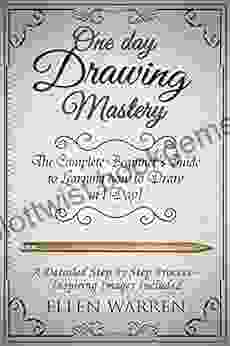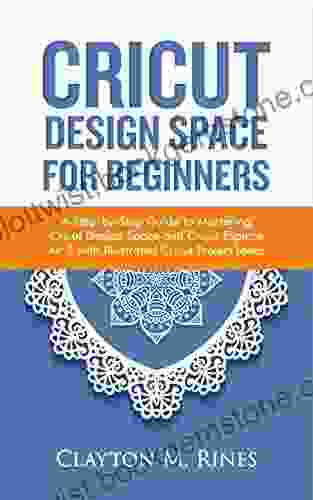Welcome to the ultimate guide for aspiring artists who yearn to unlock their inner creativity and master the art of drawing. This comprehensive article is meticulously crafted to empower beginners with the knowledge, skills, and confidence to transform their artistic dreams into reality in just one day. Whether you're a complete novice or have dabbled in sketching before, this guide will equip you with the essential techniques and step-by-step instructions to take your drawing abilities to the next level.
4.3 out of 5
| Language | : | English |
| File size | : | 2419 KB |
| Text-to-Speech | : | Enabled |
| Screen Reader | : | Supported |
| Enhanced typesetting | : | Enabled |
| Print length | : | 114 pages |
| Lending | : | Enabled |
Throughout this journey, we'll delve into the fundamentals of drawing, explore a range of drawing techniques, and provide practical tips to enhance your skills. By the end of this guide, you'll possess the tools and confidence to create captivating sketches that will impress yourself and others.
Getting Started: The Basics of Drawing
Before we embark on the exciting adventure of drawing, it's essential to establish a solid foundation in the basics. This includes understanding the fundamental elements of drawing, such as line, shape, form, texture, and space.
Line
Lines are the building blocks of drawing. They define the contours of objects, create movement, and convey emotions. Practice drawing different types of lines, such as straight lines, curved lines, and scribbles, to develop control and precision.
Shape
Shapes are two-dimensional forms that enclose space. Geometric shapes, such as squares, circles, and triangles, provide the structure for more complex objects. Practice drawing various shapes to improve your understanding of form and proportion.
Form
Form refers to the three-dimensional quality of objects. It involves creating the illusion of depth and volume on a two-dimensional surface. Practice drawing simple objects, such as spheres, cubes, and cylinders, to develop your spatial awareness.
Texture
Texture adds visual interest and realism to drawings. It refers to the surface quality of objects, such as smooth, rough, or bumpy. Practice drawing different textures by using various drawing tools and techniques.
Space
Space is the area around and between objects in a drawing. It can be used to create depth, balance, and composition. Practice arranging objects in different spatial relationships to enhance your understanding of perspective and composition.
Step-by-Step Drawing Techniques
Now that we've covered the basics, let's delve into the practical aspect of drawing. Here are some step-by-step techniques to guide you in creating your own sketches:
Contour Drawing
Contour drawing involves drawing the outlines of objects, following their contours and curves. It helps develop hand-eye coordination and an understanding of form. Start by practicing contour drawing simple objects, such as fruits or leaves.
Cross-Hatching
Cross-hatching is a shading technique that creates the illusion of depth and texture by drawing intersecting lines. Experiment with different angles and densities of cross-hatching to achieve various effects.
Stippling
Stippling is a shading technique that uses small dots to create tone and texture. It requires patience and precision, but can produce incredibly detailed and realistic drawings.
Blending
Blending involves smoothing out transitions between different tones or colors. It can be achieved using blending stumps, tortillons, or your fingers. Practice blending to create soft, gradual transitions.
Perspective Drawing
Perspective drawing is the art of creating the illusion of depth on a two-dimensional surface. It involves understanding the principles of vanishing points and horizon lines. Practice drawing simple objects in perspective to improve your spatial awareness.
Tips to Enhance Your Drawing Skills
In addition to mastering the techniques described above, here are a few additional tips to help you enhance your drawing skills:
Practice Regularly
The key to becoming a proficient drawer is consistent practice. Dedicate time each day to sketching, even if it's just for a few minutes. Regular practice will improve your hand-eye coordination, develop your muscle memory, and enhance your overall drawing abilities.
Observe the World Around You
Drawing inspiration can be found everywhere you look. Take time to observe the world around you, paying attention to the shapes, textures, and forms of objects. Study the works of master artists to learn from their techniques and compositions.
Use a Variety of Drawing Tools
Experiment with different drawing tools, such as pencils, charcoal, pastels, and markers. Each tool has its own unique characteristics and can be used to achieve different effects. Explore the possibilities and find the tools that best suit your style.
Don't Be Afraid to Make Mistakes
Mistakes are an inevitable part of the learning process. Embrace them as opportunities to learn and improve. Don't get discouraged if your drawings don't turn out perfectly at first. Keep practicing and seeking feedback to refine your skills.
Seek Feedback and Share Your Work
Constructive criticism from peers or mentors can provide valuable insights to help you identify areas for improvement. Share your drawings with others and ask for feedback to gain a fresh perspective and enhance your artistic growth.
Embarking on the journey of learning to draw can be incredibly rewarding. By following the step-by-step instructions, practicing regularly, and utilizing the tips provided in this guide, you can unlock your inner artist and create captivating sketches that will amaze yourself and others. Remember, the path to artistic excellence requires dedication, perseverance, and a passion for the craft. With each sketch you create, you'll refine your skills, expand your creativity, and discover the boundless joy that drawing brings.
So, what are you waiting for? Grab your pencils, unleash your imagination, and embark on the exciting adventure of drawing today!















































































































































































































































































































































































































































































































































































































